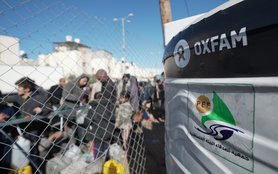El Niño weather system, in addition to a year of failed rains, blamed for severe drought
BOSTON, MA - People in parts of Ethiopia are walking for two days to get water for their families and animals as the country suffers its worst drought in thirty years.
In Siti zone in the east of the country, many people have told Oxfam that they are dependent on food aid to survive but some are sharing this with their sheep and goats in a desperate attempt to keep their animals alive as well.
The Ethiopian government estimates that 10.2 million people will need humanitarian assistance this year, at a cost of $1.4 billion. The El Niño weather system, on the back of 12 to 18 months of erratic or failed rains, has caused the worst drought in Ethiopia since the mid-1980s.
“People are watching their crops wither and their animals starve to death all the while knowing they don’t have enough food and water themselves. The Ethiopian government is doing its best but the scale of the problem requires urgent and significant funding from donors to complement the government's efforts. It’s been clear for months that this drought would have a devastating effect on Ethiopia. More needs to be done to help the country cope,” said Nigel Timmins, Oxfam’s Humanitarian Director.
Oxfam is helping over 160,000 people in three areas of the country by trucking in water, repairing boreholes and wells, and giving out animal feed. The aid agency is planning to reach 777,000 people but needs $25 million to do so.
Ethiopia’s ‘belg’ rains are due to begin in a couple of months but even if normal rainfall occurs, it will take time for people to replenish their herds and cultivate crops.
Fatuma Hersi had a herd of 300 sheep and goats of which just seven remain. The mother of eight who is now seeking help at a site for internally displaced people in Siti, said: “There have been other droughts. But this one is the worst I have seen. We are here waiting for support.”
Ethiopia is one of a number of countries struggling to cope with the effects of one of the strongest El Niños on record. Two million people across Guatemala, Honduras, El Salvador and Nicaragua need food aid, where drought has become an additional trigger for migration from rural areas to urban centers and to other countries. El Niño has also caused flooding in Paraguay and Bolivia, and drought in southern Africa and Papua New Guinea.
El Niño is a natural phenomenon that occurs periodically. Although it is not directly caused by climate change, global warming makes it more likely that strong El Niños will develop. And in turn, El Niños involve the release of a large amount of heat from the Pacific Ocean, exacerbating climate change.
Any short term response to feed those left hungry by this year’s El Niño needs to be matched with medium and long term plans to tackle climate change which makes super El Niños more likely.


